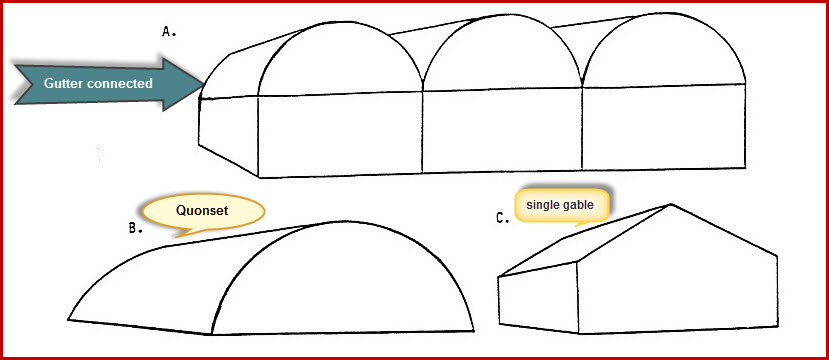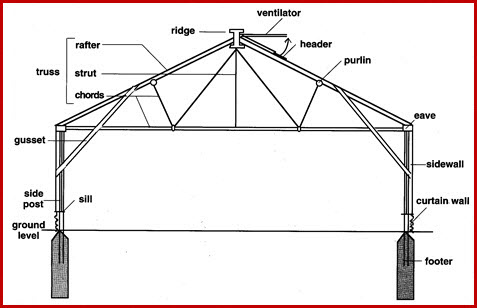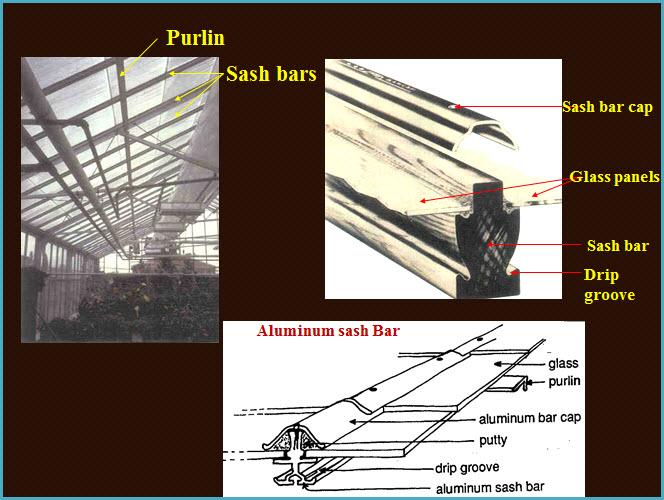Site pages
Current course
Participants
General
Module 1. History and types of greenhouse
Module 2.Function and features of greenhouse
Module 3.Scope and development of greenhouse techn...
Module 4.Location, planning and various components...
Module 5.Design criteria and calculations
Module 6. Construction materials and methods of co...
Module 7. Covering material and characteristics
Module 8. Solar heat transfer
Module 9. Solar fraction for greenhouse
Module 10. Steady state analysis of greenhouse
Lesson 4 Location, Planning and Various Components of Greenhouse
4.1 INTRODUCTION
A greenhouse, is basically the purpose of providing and maintaining a growing environment that will result in optimum production at maximum yield. The agriculture in the controlled environment is possible in all the regions irrespective of climate and weather. It is an enclosing structure for growing plants; greenhouse must admit the visible light portion of solar radiation for the plant photosynthesis and, therefore, must be transparent. At the same time, to protect the plants, a greenhouse must be ventilated or cooled during the day because of the heat load from the radiation. The structure must also be heated or insulated during cold nights. A greenhouse acts as a barrier between the plant production areas and the external or the general environment.
4.2 LOCATION OF GREENHOUSE
Selecting a “good” site for the location of a greenhouse is crucial. But what constitutes a “good” site? There are several things that should and must be considered in order to increase the chances of a successful operation and business.
4.2.1 Things to Consider While Selecting a Greenhouse Site:
1. Solar Radiation – Plants require sunlight for photosynthesis. When plants experience cloudy days their photosynthetic rates, and therefore their ability to grow and yield a product, such as tomatoes, cucumbers, peppers, etc., will be reduced. Therefore, a region and location with high light intensity year-round is desired.
2. Water – Water quantity and quality is crucial. Water will be needed for irrigation (maximum of 1 gal/plant/day for tomatoes). Water will be needed for the evaporative cooling system and can equal or exceed the irrigation water amounts (10,000 – 15,000 gal/acre/day). In the past, excess irrigation and bleed-off water from the evaporative cooling system was allowed to “run off” onto the ground adjacent to the greenhouse (with a rec. minimum percolation rate into the soil of 1″/hr.)
However, due to more strict regulations and a desire to avoid ground water contamination with high concentrations of salts, large greenhouses are now recirculating the nutrient solution. Recirculating the nutrient solution also saves water, nutrients & money.
Therefore, excess nutrient solution should be recycled and/or mixed with the cooler bleed-off water and redirected into designated areas, such as grass, shrubs, trees/windbreaks, etc.
3. Elevation – will affect the summer maximum and the winter minimum temperatures. Choosing an appropriate elevation will minimize heating costs in the winter and cooling costs in the summer.
4. Microclimate –
Latitude – Unless the global climate changes drastically, sea level at the poles will be colder than sea level in the tropics. Hence, latitude makes a difference!
Large bodies of water – will tend to moderate the temperature (e.g., coastal areas tend to have smaller day/night temperature differences than inland areas).
Trees, mountains or other obstructions – may cast shadows on the greenhouse, especially in the morning or afternoon hours. Mountains can also effect wind and/or storm patterns.
Clouds and fog – Note that certain areas (e.g., on the lee side of certain mountain ranges, or near coastal regions) may develop clouds or fog during certain times of the day or year that will reduce potential sunlight.
High Wind Areas – High winds can “suck” heat away from the greenhouse and therefore increase the heating energy needed to maintain the temperature inside. High winds can also cause structural damage to greenhouses.
Blowing dust/sand – High winds can “kick up dust or sand”, especially in desert regions, which can damage some greenhouse glazing.
Snow – The weight of heavy, wet snow on a greenhouse could crush it. However, high winds in snow areas can also blow snow up against the greenhouse structure (snow drifts) and cause damage to it. This danger can be reduced by using windbreaks (trees, snow fences, etc.).
5. Pest Pressure – Choose a site away from existing agriculture production areas which could harbor insect pests in the fields. Insect pests of concern include white flies, aphids, spider mites and thrips.
6. Level and Stable Ground – The ground upon which the greenhouse will sit must be:
Graded for routing surface water to a drainage system or a holding pond. (Typical grade = ½ % or a 6 inch drop over a distance of 100 feet.)
Compacted so there will be no settling after the greenhouse has been constructed.
7. Utilities – Availability of utilities should include telephone service, three-phase electricity and fuel for heating and carbon dioxide generation. Note that, when compared to propane, electricity or fuel oil, natural gas is a fairly economical heating energy source. However, as fossil fuel costs increase, alternative energies may become more cost effective.
8. Roads – Need access to good roads to transport the “product”. Good roads close to a large population center or to a brokerage center aids wholesale and retail marketing.
9. Greenhouse Orientation –
In Free Standing greenhouse more sunlight is available in winter in East-West oriented greenhouse.
In multi-span greenhouses, gutter should be oriented North South.
In Naturally ventilated greenhouse, the ventilator should open on the leeward side.
A free standing greenhouse should have its long axis perpendicular to the wind direction.
10. Capability of Expansion – Purchase more land than you anticipate using in the beginning so that you have the ability to expand your operation. Locate the initial greenhouses such that future expansion will utilize the land area most efficiently.
11. Availability of Labour – The grower needs people who will want to work as labourers and who are “trainable” to become a retainable workforce. Such skills included pruning/training the plants and harvesting/packing the fruit. Speciality labour will include people with additional training in such fields as plant production, plant nutrition, plant protection (insects and diseases) computers, labour management, marketing, etc. These may or may not be part of the regular workers, but may be called on as consultants as needed.
12. Management residence – The grower/manager residences should be close to the greenhouse so that they can get to the greenhouse quickly in case of emergencies.
13. Community profile: Prior to selecting a site for greenhouse construction the grower should obtain a “Community Profile” for potential locations. These are available at the city or area Chamber of Commerce and contain Community background information:
Location, elevation, history and weather.
Population, employment structure and labour force information
Growth indicators, principal economic activities and property tax information
Available properties, financing, transportation, communications and utilities
Government, medical and educational services
4.3 Various Components of Greenhouse / Poly-house
The greenhouse is a structure made by assembling different parts or components. Each part has specific role in greenhouse structure. It is covered with a transparent material for admitting natural light for plant growth. The main components of greenhouse like structure, covering/glazing and temperature control systems need proper design for healthy growth of plants.
Freestanding (single) or ridge and furrow (gutter connected) greenhouses are two common styles of commercial greenhouses. The freestanding style is often a Quonset, which will accommodate many growing situations but presents height
restrictions near the side walls. Another freestanding style is the single gable greenhouse and its many variations. The ridge and furrow or gutter connected greenhouses are joined at the eave by a common gutter. When several of these buildings are joined they are often referred to as a greenhouse range (Figure 4.3.1).

Fig.4.3.1 Commercial greenhouse structures: A) gutter connected, B) Quonset, and C) single gable.
(Source: http://pods.dasnr.okstate.edu )
4.3.1 Foundation:
The foundation must resist overturning and vertical pressure from structural loads and snow, and should extend below the frost line. Concrete is the most appropriate material for permanent structures. A 2,500 PSI or greater mix should be chosen when ready-mix concrete is used.
Unless the grower is constructing a greenhouse without the use of a manufacturer, specific recommendations are usually provided for adequate durability of the foundation. The foundation stage of construction is critical and consulting with appropriate personnel, such as experienced builders, is highly recommended.
The foundation can be 60 cm x 60 cm x 60 cm or 30 cm diameter and one meter depth in PCC of 1:4:8 ratios. The vertical poles should also be covered to the height of 60 cm by PCC with a thickness of 5 cm. This avoids the rusting of the poles.
4.3.2 Structural Components:
(Refer Fig 4.3.2)

Fig 4.3.2 Basic Structural components of greenhouse
(Source: www.kirkwood.edu )
4.3.2.1 Side Wall:
It supports the trusses and bears the weight of the greenhouse.
Set in concrete footings
Typically spaced 10 feet apart
4.3.2.2 Curtain Wall:
The first several feet of sidewall above the soil line.
Usually made of some solid building material such as poured concrete, concrete blocks, bricks, or treated lumber.
4.3.2.3 Sill: It is top of the curtain wall.
4.3.2.4 Eave:
Where the sides of the greenhouse join the roof of the greenhouse.
The “top” of the sides of the greenhouse.
4.3.2.5 Truss:
Structural component that supports the weight of the greenhouse roof.
Consists of rafters, struts, and chords.
4.3.2.6 Purlin :
Purlins run along the length of the greenhouse.
Keep the roof trusses aligned.
4.3.2.7 Ridge :
Where the roofs come together at the top of the greenhouse.
Many greenhouses have a ridge vent(s).
4.3.2.8 Side posts and columns:
These are vertical supports that dictate the height of the production area. These range from one to ten feet in height and should be given serious consideration since they directly influence efficiency (Figure 4.3.2).
4.3.2.9 Sash Bar:
Refer Fig 4.3.3
Run perpendicular to the purlins.
Attached to the purlins.
Hold the glazing in place.
Sometimes built with a drip groove or channel to catch condensation that forms on the inside of the glass panels

Fig 4.3.3 Sash Bars
(Source: www.kirkwood.edu )
4.3.4 Framing Materials
Aluminum is the most economical material for constructing the greenhouse frame. It can be shaped as needed to form various structural components of the greenhouse and needs no maintenance after installation. Aluminum framing also has the longest life span and allows for light reflectance.
Steel is commonly used but must be painted or galvanized to resist high moisture conditions within the greenhouse. Steel needs more maintenance than aluminum and is heavier, requiring additional support.
Wood was once a common framing material, but it has steadily lost popularity for number of reasons. The main disadvantage of wood is that it deteriorates over time. If wood is desired, pressure treated lumber should be purchased and then treated with commercially available coatings. Avoid PENTA and creosote since they liberate fumes that are harmful to plants.
4.3.5 Coverings:
Glass allows maximum light transmission in greenhouse production. Despite this, there are several disadvantages to consider. Glass is expensive and, because it is fragile, has to be replaced more often than many other materials in the market today. Also, consider that when using glass, the cost of structural components will be expensive because of the added weight which must be supported. When glass is desired, check with the manufacturer for double and triple strength ratings available. Also, “hammered” or “frosted” panes will distribute incoming light better by dispersing the rays, resulting in fewer shadows. This type of glass is not transparent from the outside, which can be an added security benefit in certain institutions.
A double layer of polyethylene, inflated with air, is another option to consider for covering the greenhouse. One advantage of using this material is that it is relatively inexpensive. Materials have greatly improved and some manufacturers guarantee their materials for up to four years. Look for ultraviolet stabilized products that are slower to yellow and crack. Single and triple layer polyethylene coverings are used less commonly. Replacement of a polyethylene covering as a result of wind, hail, or solar damage will be more frequent than any other covering, but the low investment and the need for less structural components make it a material to consider when a temporary greenhouse is desired. Two additional products, available commercially, to extend the life of a polyethylene house are poly patch and anti-drip material. The anti-drip material reduces condensation that can harm plants growing below. Condensation should also be controlled to prevent lowered light transmission, especially during the winter months when low light levels may limit plant growth.
Fiberglass is another material that has gained popularity over glass. It is very durable, rigid, and available in various light transmission levels. Ultraviolet light will cause fiberglass to deteriorate in a few years from swelling and fraying of the
fibers. This in turn quickly leads to lowered light transmission to the plants. However, there are products now available that will help to reduce the fraying. These coatings should be applied prior to damage to the fiberglass. Although the life span of fiberglass can be as short as five years, choosing higher grade products and applying a coating may result in a twenty year life span.
Polycarbonate is one of the newest materials available and is still being evaluated. This material is rigid but also flexible enough to be used in a Quonset style greenhouse. Although the initial cost of polycarbonate is high, a ten to 15 year life span can be expected. Polycarbonate can be purchased in double and triple walled forms which are highly impact resistant.
Acrylic is also new and expensive but it has a minimum ten year warranty from some manufacturers. Although many advantages exist such as high light transmittance, high impact resistance, and great strength, costs have proven prohibitive in most cases.
Remember to check with the covering manufacturer for several factors.
1. Combustibility - Some materials may result in lower insurance premiums if they are fire retardant. Other materials are highly flammable, such as fiberglass reinforced panels (FRP), and that must be considered. Fire retardant FRP panels can be purchased.
2. Durability - Not only will this differ among materials, but also will be determined by whether they are one, two, or three ply.
3. Insulation - Note insulation “R” factor and compare for fuel savings. Heat retention from highest to lowest:
Acrylic (double layer)
Polycarbonate (double layer)
Glass (double layer)
Polyethylene (double layer)
Fiberglass
Keep in mind that this is relative to the number and thickness of layers used.
4. Life span.
5. Care - Maintenance may be required to realize life span claims from manufacturer.
6. Guarantee - Read warranties carefully as most will be limited.
4.3.6 Shading Compounds
During the summer months ,when solar radiations are too intense for any crops to be grown to acceptable quality. Shading is necessary to make greenhouses usable and to prevent overtaxing the cooling and ventilation systems. Instructions are provided to reach the desired percentage of radiation blockage. Liquid formulas are commonly used for glass and sometimes fiberglass. However, frayed fiberglass may absorb the liquid, making it impossible to remove when maximum solar radiation is again needed. Another alternative is to use shade cloth. It can be purchased for the per cent of solar radiation reduction desired, depending on the crops grown.
Source:
1. http://tnau.ac.in : Planning of greenhouse facility
2. http://ag.arizona.edu : Greenhouse site selection
3. http://pods.dasnr.okstate.edu : Greenhouse Structure and Coverings